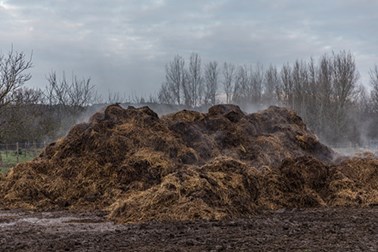Five key factors in positioning a muckheap

 Horses can produce around 3-5% of their body weight in dung every day. The average 16hh horse produces around 18kg of manure each day, that’s around 6.5 tonnes of the stuff annually, not even accounting for any bedding that goes with it. This can all add up to a very big headache for any horse owner or yard manager!
Horses can produce around 3-5% of their body weight in dung every day. The average 16hh horse produces around 18kg of manure each day, that’s around 6.5 tonnes of the stuff annually, not even accounting for any bedding that goes with it. This can all add up to a very big headache for any horse owner or yard manager!
Location is everything as they say; carefully choosing where to position your dung heap and managing it appropriately will help to protect the health of your horses and the land. This will:
- Make it easier to use
- Help it rot down more quickly
- Reduce the chance of reinfection from parasites
- Lower pollution risk
- Limit areas where insects such as midges can breed
One. Making it easier to use
Site your muckheap for convenience to the yard, but not so close as to cause possible horse health problems or irritation from flies. Bear in mind that large heaps can be a nuisance to neighbours or people using public rights of way. The area should be easily accessible by large vehicles if you need to have it removed regularly. Another alternative is to tip your muck straight into a trailer for easy disposal.
Two. Helping it rot down more quickly
It all comes down to good husbandry – a perfectly manicured muckheap is one of life’s goals and there is method in the madness. Sprawling heaps are inefficient and a poor use of space. Try to put your pile against a defined boundary or wall to make it easier to throw the muck on top. Keeping your heap contained and condensed and trampling to reduce the volume will help the decomposition process happen much faster.
Three. Reducing the chance of reinfection from parasites
Muckheaps should never be created in fields accessible to horses. Let’s face it, poo picking is hard work and often a temporary muckheap nearer to the source makes the job a lot more palatable! Make sure you’re not wasting all that hard work by aiding parasite reinfection. Larvae from hatching redworm eggs can wriggle up to three metres away from dung piles. If you have a muckheap near the field, fence it off so that horses can’t graze nearby.
Four. Lowering pollution risk
Effluent – that’s the stinky black water that leaches from large manure piles - can cause serious pollution if it is allowed to enter watercourses. For this reason the Environment Agency recommends that “Temporary field heaps should be sited where there is no risk of runoff polluting watercourses. They should be at least 10 metres from a watercourse and 50 metres from a well, spring or borehole that supplies water for human consumption or for use in farm dairies.”
Pollution occurs because organisms feed on the watery dung and the nutrient enrichment encourages the growth of aquatic vegetation which has an oxygen reducing effect in the water, lowering water quality. Run off can also detrimentally affect hedgerows because nutrient enrichment encourages the growth of weeds which disadvantages hedge growth. Water contamination is prosecutable under the Environmental Protection Act, 1990, the Groundwater Regulations 1998 and the Water Resources Act 1991.
Five. Limiting areas where insects such as midges can breed
Ideally a muck heap, and the area around it, should be on a solid base, e.g. concrete. This will make it easier to sweep up and keep tidy and for vehicles to get to the heap without churning up the soil. Reducing standing water where insects such as midges can breed helps to lessen irritation and problems such as sweet itch.